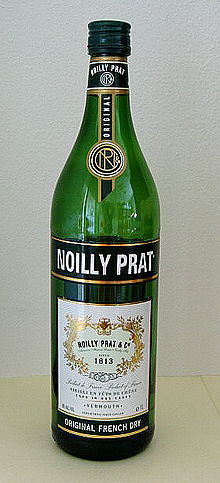- Noilly Prat
-
Noilly Prat (French pronunciation: [nwaˈji pʁat]) was originally a dry, straw-hued vermouth from Marseillan, in the Hérault département of southern France. Joseph Noilly, a herbalist, developed the first formula in 1813. It was the first example of a dry vermouth and is among the golden, straw and white vermouths generally known as "French Vermouth". Noilly's Red and Ambre versions were introduced in the 1960s and 1980s respectively and are less widely known. Noilly Prat Dry is 18% alcohol by volume.
Contents
History
It has long been known that leaving wine in a barrel alters its characteristics. Wine that was transported long distances in barrels and exposed to the weather became darker in colour and fuller-flavoured. It was to mimic this natural process that Joseph Noilly, in 1813, designed a process that made France's first vermouth. In 1855, his son Louis Noilly and son-in-law Claudius Prat set up the company that became Noilly Prat, moving the business to Marseillan where it remains to this day. The brand was acquired by Martini & Rossi in 1971 and is now a part of the Bacardi-Martini family of brands.
Manufacturing process
The process used today is virtually unchanged since the 1850s. Noilly Prat is made exclusively from white grape varieties grown in the Marseillan area, principally Picpoul de Pinet and Clairette. These produce light, fruity wines which are matured in massive Canadian oak casks inside the original storerooms. The wine stays in these casks for 8 months, maturing and absorbing the flavour of the wood, before being transferred to smaller oak barrels which are taken outside and left for a year. Here they are exposed to the sun, wind, and low winter temperatures, while the wine is slowly changing. The result is a wine that is dry, full-bodied and amber coloured, similar to Madeira or Sherry. During the year outside, 6 to 8% of the volume is lost to evaporation, the "angels' share".
Brought back inside and left to rest for a few months, the wines are then blended together into oak casks. A small quantity of Mistelle (grape juice and alcohol) is added to the wines in order to soften them, along with a dash of fruit essence to accentuate their flavour.
In the oak casks, a process of maceration, supposedly unique to Noilly Prat, takes place over a period of three weeks. A blend of some twenty herbs and spices is added by hand every day. The exact mix of herbs and spices that goes into Noilly Prat is a closely guarded secret, but includes camomile, bitter orange peel, nutmeg, centaury (Yellow Gentian), coriander, and cloves. After a further six weeks, the finished product is ready for bottling and is shipped in tankers to Beaucaire, Gard where it is bottled by Martini & Rossi.
Variants
The vast bulk of Noilly Prat is the Original French Dry vermouth, but two special variants are made:
- Red Noilly Prat is made in the same exacting way, but with the addition of 30 flavourings, which produce the rich red colour. It is not sold in France, except from the Noilly Prat shop in Marseillan, being produced for export, principally to the USA.
- Ambre Noilly Prat is available for purchase from the Noilly Prat shop in Marseillan and specialised stores.
Cocktails
Noilly Prat is often used in cocktails, the most common and well-known of which is probably the Martini, consisting of one part Noilly Prat to one part gin, with a dash of orange bitters[1]. However, the recipe used for export to the USA was changed in 2009 to a sweeter and more herbal formulation, closer to Noilly's original formula used in Europe. The change in recipe was accompanied by a change in the bottle's design.[2] Some recipes have now substituted a vermouth from Dolin instead of Noilly Prat for making martinis,[3] which is said to be "every bit as good as, although not by any means identical to, the old Noilly".[4]
Cooking with Noilly Prat
Noilly Prat is widely used in cooking, and extensively used for sauces, especially to accompany fish. In his BBC TV series French Odyssey, Rick Stein described Noilly Prat as a "true flavour from the Languedoc" and said, "I've done lots of experiments with white wines for fish sauces and I've come to the conclusion that Noilly Prat is the best. In fact, it makes very little difference to the finished sauce how good a white wine is (though this is not the case with red wine). However, the Provençal herbs and spices used to flavour Noilly Prat seem to add flavour to the reduction."[5]
Visits
The Noilly Prat cellars are open to the public from March to November, for a small charge.[6] Tour guides explain the whole process, and finish by giving visitors a taste of each of the three varieties of Noilly Prat produced. A major draw for visitors to the area, Noilly Prat attracts more than 80,000 tourists every year.
Trivia
Noilly Prat was the name given by T. S. Eliot to his cat.
References
- ^ Classic Recipes: MARTINI Cocktail, Noilly Prat website
- ^ Felten, Eric (2009-01-10). "Don't Shoot the Messenger: Bad News for Martini Drinkers". Wall Street Journal. http://online.wsj.com/article/SB123154573030469717.html.
- ^ Coudal, Jim. "Perfect". http://coudal.com/perfect.php.
- ^ Coudal, Jim (2010-12-22). "Perfect Remixed". http://coudal.com/archives/2010/12/perfect_remixed.php.
- ^ Rick Stein, French Odyssey, Programme 9, BBC
- ^ "Planning a Visit". Noilly Prat & Cie. http://www.noillyprat.com/default.aspx#navigationPath=Story.PlanVisit&commandIndex=2. Retrieved 2009-01-29.
External links
Further reading
- Green Guide: Languedoc, Roussillon, Tarn Gorges Michelin & Cie (1998), p 337 ISBN 2-06-136602-3
Categories:- Brand name alcohol products
- Vermouth
- French wine
Wikimedia Foundation. 2010.


